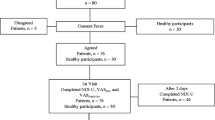Abstract
Background
Neck disability index (NDI) is one of the commonest patient-reported outcome measures used to evaluate disability related to neck pain. Its application to non-English-speaking Punjabi population is limited as a validated and cross-culturally adapted Punjabi version of NDI is not available. The purpose of the study was to analyze the psychometric properties of Punjabi version of neck disability index (NDI-P) in patients with neck pain.
Materials and Methods
The translation and cross-cultural adaptation of Punjabi version of NDI was done according to well-recommended guidelines. The pre-final version was tested on a set of 15 patients and suitable modifications were made. The final version was administered to 100 patients with neck pain of more than 2 weeks duration. Psychometric properties comprising internal consistency, test–re-test reliability, construct validity and factorial structure of the questionnaire were determined.
Results
The developed NDI-P showed excellent internal consistency (Chronbach alpha of NDI-P is 0.87), test–re-test reliability (ICC 0.840) and construct validity (Spearman correlation coefficient with VAS 0.547). Factor analysis proved the questionnaire to be having a 2-factor structure with a total variance of 56.58%.
Conclusion
NDI (P) is a reliable and valid instrument for measurement of disability related to neck pain in Punjabi population. It can be used both in research and clinical care settings in future.



Similar content being viewed by others
References
Vos, T., Allen, C., Arora, M., Barber, R. M., Bhutta, Z. A., Brown, A., et al. (2016). Global, regional, and national incidence, prevalence, and years lived with disability for 310 diseases and injuries, 1990–2015: a systematic analysis for the Global Burden of Disease Study 2015. The Lancet, 388(10053), 1545–1602.
Wheeler, A. H., Goolkasian, P., Baird, A. C., & Darden, B. V. I. (1999). Development of the neck pain and disability scale: Item analysis, face, and criterion-related validity. Spine, 24(13), 1290.
Macdermid, J. C., Walton, D. M., Avery, S., Blanchard, A., Etruw, E., Mcalpine, C., et al. (2009). Measurement properties of the neck disability index: A systematic review. Journal of Orthopaedic and Sports Physical Therapy, 39(5), 400–417.
Yao, M., Sun, Y. L., Cao, Z. Y., Dun, R. L., Yang, L., Zhang, B. M., et al. (2015). A systematic review of cross-cultural adaptation of the neck disability index. Spine, 40(7), 480–490.
Beaton, D. E., Bombardier, C., Guillemin, F., & Ferraz, M. B. (2000). Guidelines for the process of cross-cultural adaptation of self-report measures. Spine, 25(24), 3186–3191.
Mousavi, S. J., Parnianpour, M., Montazeri, A., Mehdian, H., Karimi, A., Abedi, M., et al. (2007). Translation and validation study of the Iranian versions of the neck disability index and the neck pain and disability scale. Spine, 32(26), E825–E831.
Vernon, H., & Mior, S. (1991). The neck disability index: A study of reliability and validity. Journal of Manipulative and Physiological Therapeutics, 14(7), 409–415.
Trouli, M. N., Vernon, H. T., Kakavelakis, K. N., Antonopoulou, M. D., Paganas, A. N., & Lionis, C. D. (2008). Translation of the neck disability index and validation of the Greek version in a sample of neck pain patients. BMC Musculoskelet Disorders, 9(1), 106.
Nakamaru, K., Vernon, H., Aizawa, J., Koyama, T., & Nitta, O. (2012). Crosscultural adaptation, reliability, and validity of the Japanese version of the neck disability index. Spine, 37(21), E1343–E1347.
Shaheen, A. A. M., Omar, M. T. A., & Vernon, H. (2013). Cross-cultural adaptation, reliability, and validity of the Arabic version of neck disability index in patients with neck pain. Spine, 38(10), E609–E615.
Aslan, E., Karaduman, A., Yakut, Y., Aras, B., Simsek, I. E., & Yaglý, N. (2008). The cultural adaptation, reliability and validity of neck disability index in patients with neck pain: A Turkish version study. Spine, 33(11), E362–E365.
Guzy, G., Vernon, H., Polczyk, R., & Szpitalak, M. (2013). Psychometric validation of the authorized Polish version of the neck disability index. Disability and Rehabilitation, 35(25), 2132–2137.
Uthaikhup, S., Paungmali, A., & Pirunsan, U. (2011). Validation of Thai versions of the neck disability index and neck pain and disability scale in patients with neck pain. Spine, 36(21), E1415–E1421.
Wlodyka-Demaille, S., Poiraudeau, S., Catanzariti, J.-F., Rannou, F., Fermanian, J., & Revel, M. (2002). French translation and validation of 3 functional disability scales for neck pain. Archives of Physical Medicine and Rehabilitation, 83(3), 376–382.
Agarwal, S., Allison, G. T., Agarwal, A., & Singer, K. P. (2006). Reliability and validity of the Hindi version of the neck pain and disability scale in cervical radiculopathy patients. Disability and Rehabilitation, 28(22), 1405–1411.
Song, K.-J., Choi, B.-W., Kim, S.-J., & Yoon, S.-J. (2009). Cross-cultural adaptation and validation of the Korean version of the neck disability index. Journal Korean Orthopaedic Association, 44(3), 350–359.
Terwee, C. B., Bot, S. D., de Boer, M. R., van der Windt, D. A., Knol, D. L., Dekker, J., et al. (2007). Quality criteria were proposed for measurement properties of health status questionnaires. Journal of Clinical Epidemiology, 60(1), 34–42.
Salo, P., Ylinen, J., Kautiainen, H., Arkela-Kautiainen, M., & Häkkinen, A. (2010). Reliability and validity of the Finnish version of the neck disability index and the modified neck pain and disability scale. Spine, 35(5), 552–556.
Wu, S., Ma, C., Mai, M., & Li, G. (2010). Translation and validation study of Chinese versions of the neck disability index and the neck pain and disability scale. Spine, 35(16), 1575–1579.
Cook, C., Richardson, J. K., Braga, L., Menezes, A., Soler, X., Kume, P., et al. (2006). Cross-cultural adaptation and validation of the Brazilian Portuguese version of the neck disability index and neck pain and disability scale. Spine, 31(14), 1621–1627.
Cleland, J. A., Fritz, J. M., Whitman, J. M., & Palmer, J. A. (2006). The reliability and construct validity of the neck disability index and patient specific functional scale in patients with cervical radiculopathy. Spine, 31(5), 598–602.
Cleland, J. A., Childs, J. D., & Whitman, J. M. (2008). Psychometric properties of the neck disability index and numeric pain rating scale in patients with mechanical neck pain. Archives of Physical Medicine and Rehabilitation, 89(1), 69–74.
Deyo, R. A., Diehr, P., & Patrick, D. L. (1991). Reproducibility and responsiveness of health status measures statistics and strategies for evaluation. Controlled Clinical Trials, 12(4), S142–S158.
Dawson, J., Fitzpatrick, R., Carr, A., & Murray, D. (1996). Questionnaire on the perceptions of patients about total hip replacement. Journal of Bone and Joint Surgery British Volume, 78(2), 185–190.
Andrade Ortega, J. A., Delgado Martínez, A. D., & Almécija, R. R. (2010). Validation of the Spanish version of the neck disability index. Spine, 35(4), E114–E118.
Lue, Y.-J., Chen, C.-H., Chou, S.-H., Lin, C.-L., Cheng, K.-I., & Lu, Y.-M. (2018). Development and validation of Taiwanese version of the neck disability index. Spine, 43(11), E656.
Cramer, H., Lauche, R., Langhorst, J., et al. (2014). Validation of the German version of the neck disability index (NDI). BMC Musculoskeletal Disorders, 15, 91.
Monticone, M., Ferrante, S., Vernon, H., Rocca, B., Dal Farra, F., & Foti, C. (2012). Development of the Italian version of the neck disability index. Spine., 37(17), E1038–E1044.
Funding
None.
Author information
Authors and Affiliations
Corresponding author
Ethics declarations
Conflict of Interest
The authors declare that they have no conflict of interest.
Ethical Standard Statement
This article does not contain any studies with human or animal subjects performed by the any of the authors.
Informed Consent
For this type of study informed consent is not required.
Additional information
Publisher's Note
Springer Nature remains neutral with regard to jurisdictional claims in published maps and institutional affiliations.
Electronic supplementary material
Below is the link to the electronic supplementary material.
Rights and permissions
About this article
Cite this article
Sandal, D., Jindal, R., Gupta, S. et al. Reliability and Validity of Cross Culturally Adapted Punjabi Version of NDI (NDI-P) in Patients with Neck Pain: A Psychometric Analysis. JOIO 55, 918–924 (2021). https://doi.org/10.1007/s43465-020-00280-7
Received:
Accepted:
Published:
Issue Date:
DOI: https://doi.org/10.1007/s43465-020-00280-7




